Effective Live Trapping Techniques for Opossums


Intro
Understanding how to manage opossum populations is essential for homeowners and pest control professionals alike. Opossums, despite being beneficial in many respects, can also create challenges when they invade living spaces or gardens. This article aims to inform readers about effective and humane live trapping techniques suitable for managing opossum populations. By fostering a better understanding of these creatures, their behaviors, and the ethical considerations surrounding trapping, we can promote more thoughtful strategies for coexistence.
Understanding the Pest
Identification
Opossums, specifically the Virginia opossum (Didelphis virginiana), are easily identified by their grayish-white fur, pointed snout, and long, hairless tail. Adult opossums typically weigh between 4 to 14 pounds and can measure from 24 to 33 inches in length. Recognizing these unique characteristics can assist in differentiating opossums from other wildlife species.
Life Cycle
The life cycle of an opossum begins with a gestation period of about 12 days. Female opossums give birth to around 6 to 9 tiny, underdeveloped joeys, which then crawl into the mother's pouch. After approximately two months, these young opossums begin to venture outside but remain with their mother for several more weeks. Opossums are generally nocturnal, becoming active at night to search for food, which includes insects, fruits, and carrion.
Pest Prevention Strategies
Environment Modification
To reduce the likelihood of opossums visiting your property, certain modifications in the environment can be effective. Keeping garbage cans securely closed, removing pet food from outdoor areas, and securing compost piles can help deter these animals. Additionally, clearing away fallen fruit from trees and keeping gardens tidy can diminish food sources. This makes the environment less appealing for opossums.
Physical Barriers
Installing physical barriers is another effective strategy. Fencing, for instance, can prevent opossums from accessing gardens and yards. It is important to ensure the fence is high enough and buried a foot underground, as opossums are adept climbers and diggers. Preventive measures are often more efficient than reactive ones, allowing for a more harmonious living experience.
Proper environmental management is crucial for minimizing the attraction of opossums to your property.
Control Methods
Chemical Control
Chemical control methods, while potentially effective, often raise ethical concerns in relation to opossum management. This method is generally not recommended due to the potential harm it can cause to non-target species and the environment. Instead, humane trapping methods remain the most acceptable approach in managing opossum populations.
Biological Control
Biological control, although not a common strategy for opossums, involves managing the ecosystem in a way that naturally limits their population. This can include fostering a presence of natural predators or promoting a balanced food web that reduces the food availability for opossums.
Prologue to Opossums
Understanding opossums is vital for effective live trapping and management. Opossums are often misunderstood creatures, seen as pests rather than significant contributors to the ecosystem. This section aims to unravel the biological aspects and ecological role of opossums, providing important context for why humane trapping techniques are essential.
Biological Characteristics
Opossums are unique marsupials native to North America. They are typically characterized by their pointed faces, prehensile tails, and a notable ability to play dead as a defense mechanism. Adult opossums weigh between five to fourteen pounds and can typically measure about thirty-one inches long, including the tail.
The fur of opossums is usually gray and coarse. Their sharp, dental structure includes fifty teeth, the most of any land mammal. This adaptation allows them to process a varied diet that includes fruits, insects, and even carrion. Awareness of these biological features is crucial when selecting traps, as the size and design must accommodate their physical characteristics while ensuring humane treatment during capture.
Ecological Importance
Opossums play a significant ecological role. They are natural scavengers, helping to control insect populations and clean up carrion, which reduces the spread of disease. This behavior supports a balanced ecosystem and promotes health within their habitats. Opossums also consume pests such as ticks, which can carry Lyme disease, effectively keeping their numbers in check.
Moreover, opossums are immune to many diseases that affect other animals, such as rabies. Their unique traits make them less of a threat compared to other wildlife. Understanding their ecological importance can shift the perspective from viewing them simply as pests to recognizing them as valuable participants in maintaining environmental balance.
"Opossums are often referred to as nature's cleanup crew for their role in pest control and disease management."
Understanding Live Traps
Understanding live traps is crucial for effective opossum management. Live traps not only allow for humane capture but also ensure that the animals can be relocated safely. When considering the importance of live traps, remember that they help maintain a balance between human needs and wildlife conservation. By employing the right trapping techniques, you can minimize stress for the animals involved while meeting your goals of population control.
Definition and Purpose
Live traps are specialized devices designed to capture animals without causing harm. The primary purpose of these traps is to safely enclose an animal, allowing it to be transported and released at a separate location. This non-lethal approach addresses both the need to manage opossum populations and to preserve the ecological balance in your area. Knowing how to utilize such traps effectively is essential for any homeowner facing challenges with opossums.
Types of Live Traps
Different types of live traps exist, each with unique features that cater to specific situations and preferences.
Box Traps
Box traps are solid, enclosed traps that provide a safe space for the captured opossum. These traps are popular due to their simplicity and effectiveness. A key characteristic of box traps is their sturdy construction, which prevents escape. They often come with a spring-loaded mechanism that closes the entrance once the animal enters.
One unique feature is their size variety; they can accommodate different animal sizes, making them versatile in application. The primary advantage of box traps is their ability to contain the animal securely, reducing the chance of injury. However, one disadvantage is that they may require positioning in areas with ample space to set up properly.
Cage Traps
Cage traps involve an open design with wire covering the sides. This type of trap is beneficial for monitoring and observing the captured animal. The open design ensures adequate ventilation, reducing stress during confinement. A significant aspect of cage traps is their easy portability, allowing for quick movement and relocation.
However, the unique feature of cage traps can also be a downside; the exposed design may lead to external influences stressing the captured animal. Still, they remain a favored choice due to their effectiveness and ease of use.
Funnel Traps
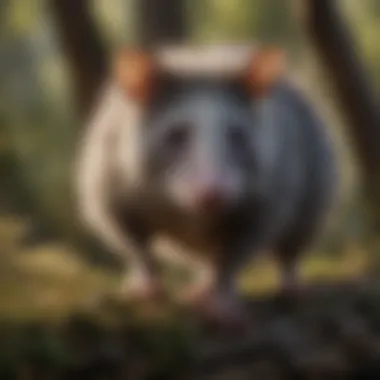
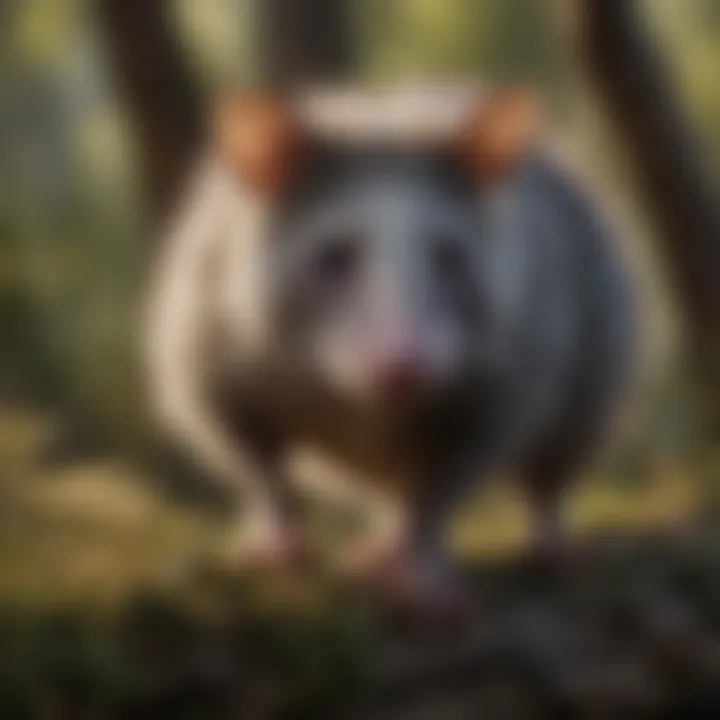
Funnel traps operate on a simple concept. They feature a funnel-shaped entry that allows animals to enter but not exit. This design is beneficial for trapping multiple opossums at once, which can lead to more efficient management. A key benefit of funnel traps is that they can be set up quickly and in various locations.
Nevertheless, a point of caution is that funnel traps may not offer the same level of security once the animal is captured. Additionally, they require careful placement to prevent non-target species from entering. Their unique design can be particularly advantageous in areas with ample movement paths for opossums.
"Choosing the right type of live trap is essential for successful opossum management. Each type has its own advantages and should be evaluated based on your specific needs."
By understanding the available options and their distinct characteristics, you can make informed decisions about which traps to use for managing opossum populations effectively.
Selecting the Right Trap for Opossums
Choosing the appropriate trap for live trapping opossums is crucial for successful outcomes. The right trap ensures that the animal is captured effectively without causing harm. This choice affects not only the efficiency of trapping but also the welfare of the animal. A good trap minimizes stress for the opossum while maximizing the chances of a successful capture. Understanding the specifics around size, dimensions, and material consideration is essential.
Size and Dimensions
The size and dimensions of the trap play a significant role in capturing opossums, which are medium-sized marsupials. Traps must be spacious enough to accommodate these animals comfortably yet secure enough to prevent escape. Generally, traps that measure approximately 32 to 36 inches in length and 10 to 12 inches in width are ideal for opossums. This size allows the animal to enter fully, ensuring that it triggers the mechanism effectively.
When selecting a trap, consider the size of adult opossums, which can weigh between 8 to 14 pounds. A trap that is too small may cause injury, while one that is excessively large may fail to contain the animal properly. Proper sizing becomes crucial. Additionally, when traps are larger, they may attract other undesired species, which complicates the trapping process.
Material Considerations
Material plays a significant role in the durability and effectiveness of the trap. Traps made from galvanized steel or heavy-duty wire are ideal. These materials provide strength against potential damage from captured opossums or other wildlife. It is important to ensure that the material can withstand varying weather conditions to prevent rust and wear, thus extending the trap's lifespan.
Furthermore, material selection impacts the trap's safety features. A design that has a smooth interior prevents physical injuries to the captured animal. Some traps utilize a pan or trigger system that requires careful attention to the construction, ensuring that it functions without harming the opossum once it enters. The right material not only enhances functionality but also contributes to humane practices in trapping.
"Selecting a suitable trap is a vital step that directly influences both capture efficiency and animal welfare."
Overall, selecting the right trap for opossums involves careful consideration of size, dimensions, and material. Investing time in this crucial aspect will pay off, ensuring not only effective trapping but also adherence to ethical standards. Proper trapping strategies can lead to successful population management, making it vital for those interested in humane practices.
Locating Traps Effectively
Locating traps effectively is crucial in the successful management of opossum populations. Understanding where to position traps can significantly improve the chances of capturing these animals humanely. Various factors influence trap placement, and knowing these can save time and resources while enhancing overall efficacy.
Analyzing Opossum Behavior
To locate traps effectively, one must start with an analysis of opossum behavior. Opossums are nocturnal creatures, usually active during the night. They are instinctively curious, which often leads them to explore new areas, especially in search of food. Understanding their habits can guide homeowners in determining the best locations for traps.
- Here are some behaviors to observe:
- Feeding Patterns: Opossums typically frequent areas where food waste is available. Look for signs of feeding, like disturbed trash or droppings.
- Travel Paths: Note the routes they take when navigating through gardens or backyards. Opossums often travel along fences or shrubs. This information can help identify their pathways and serve as potential trap locations.
- Hiding Spots: They tend to favor dark, secluded areas to sleep during the day. Identifying potential den sites can further inform trap placement.
By carefully analyzing these behaviors, homeowners can increase the effectiveness of trap locations. Additionally, understanding the environmental factors that attract opossums plays a key role in trapping success.
Optimal Trap Placement
Choosing the optimum placement for traps can determine the success of a trapping effort. Here are several considerations for optimal trap placement:
- Proximity to Food Sources: Place traps near areas where food waste is present. Common locations include garbage cans, compost piles, or pet food dishes left outside.
- Pathway Alignment: Align traps along observed pathways. Traps positioned in these areas are more likely to capture opossums as they forage.
- Cover and Concealment: Utilize shrubs, trees, or other natural barriers to conceal the traps. Opossums are more likely to approach a trap if they feel secure and hidden from potential threats.
- Avoiding High Traffic Areas: While traps should be near food sources, they should also avoid excessively busy locations where non-target animals or pets might trigger the traps.
Remember: Frequent monitoring of traps is essential after placement. This not only ensures that traps are functional but also limits stress for captured animals.
Baiting Strategies
Baiting plays a crucial role in the overall effectiveness of live trapping techniques for opossums. The right bait can significantly increase the chances of attracting these nocturnal creatures into the traps. It is essential to understand that opossums have specific dietary preferences, which means selecting the right bait involves considering their natural eating habits. With proper baiting strategies, one can achieve higher capture rates, making the whole process more efficient and humane.
Choosing Effective Baits
Selecting effective baits is paramount for successful trapping. Opossums are omnivorous, which means they consume a variety of foods. It is beneficial to focus on foods that mimic their natural diet. Some effective bait options include:
- Fruits: Ripe bananas, apples, or melons are attractive to opossums due to their sweetness.
- Meats: Canned tuna or salmon can be utilized, as the odor is enticing for these marsupials.
- Pet Food: High-quality cat or dog food tends to work well as it is rich in protein.
- Peanut Butter: This sticky substance can be placed on pieces of bread, encouraging opossums to spend more time at the trap.
It is crucial to ensure that the bait is fresh. Spoiled or old bait will not attract opossums and could even repel them. Additionally, making the bait easily accessible while ensuring it is secured within the trap will minimize the chances of non-target animals being attracted.
Baiting Techniques
Using effective bait is only part of the strategy. Employing proper baiting techniques can enhance capture success as well. Here are key techniques to consider:
- Smear Technique: Smearing bait like peanut butter inside the trap can encourage opossums to investigate further, leading them deeper into the trap.
- Placement: Position the bait at the back of the trap. This compels the opossum to enter, triggering the trap's mechanism.
- Scent Trail: Creating a scent trail leading to the trap may lure opossums in. This can be achieved by placing small amounts of bait leading to the trap's entrance.
- Avoid Human Scent: Minimize human scent on traps and bait. This can be done by wearing gloves while handling the bait and trap, as a human scent can deter opossums.
Using thoughtful baiting strategies not only leads to humane trapping but also aids in managing opossum populations effectively.
By applying these baiting strategies, homeowners and pest control professionals can ensure a more successful and humane trapping experience. This ultimately fosters a better understanding of opossum behavior and the intricacies of effective live trapping.
Monitoring Traps
Monitoring traps is a critical component in the process of live trapping opossums. The efficiency and effectiveness of trapping efforts rely heavily on how well the traps are monitored. This section will explore the importance of routinely checking traps, the optimal frequency for these checks, and the necessary considerations for minimizing stress on captured opossums.
Checking Frequency
The frequency with which traps are checked plays a significant role in humane trapping practices. Ideally, traps should be inspected at least once every 12 hours. This minimizes the time an opossum remains captured. Prolonged periods in a confined space can lead to unnecessary stress and suffering for the animal.
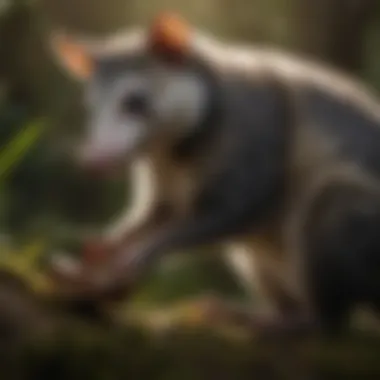
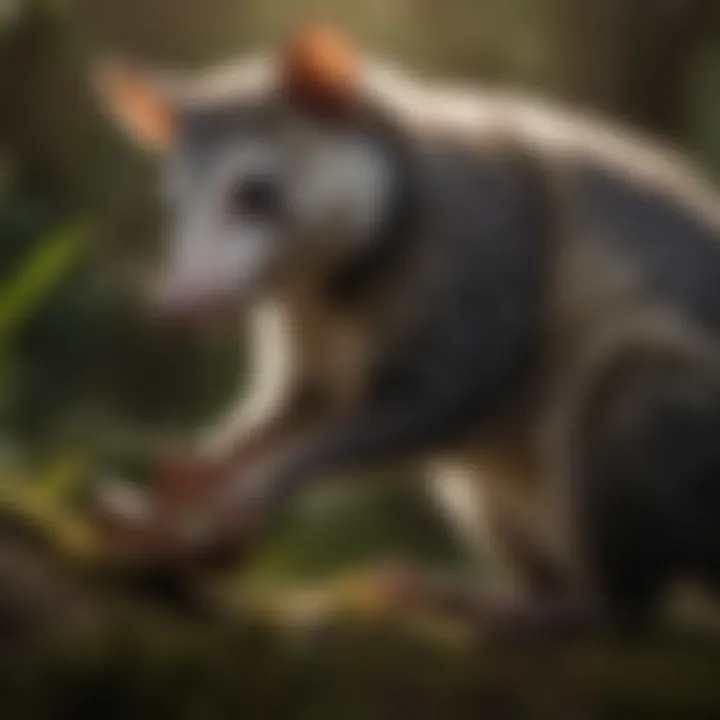
There are several factors that influence checking frequency:
- Environmental Conditions: In warmer climates, more frequent checks may be necessary to prevent heat stress.
- Time of Year: During seasons when opossums are more active, such as spring or summer, checking traps more often can increase success rates.
- Local Regulations: Some regions may have specific laws regarding the time limit for checking traps, which should always be observed.
Frequent checks not only improve the welfare of the captured animal but also ensure that the traps remain effective. For instance, if a trap is found to be empty multiple times, it may need to be repositioned or, possibly, baited again.
No doubt, a well-monitored trap contributes positively to the overall success of a trapping program.
Avoiding Stress for Captured Opossums
Minimizing stress for captured opossums is essential for responsible live trapping. It is critical for both ethical and practical reasons. Stress can impair an opossum's health and survival capabilities once released. Here are some techniques to alleviated the stress experienced by the animals:
- Limit Handling: Once an opossum is captured, limit direct contact. Use protective gloves when handling traps to avoid transferring human scent onto the trap.
- Cover the Trap: Immediately covering the trap with a blanket or tarp after capture can help reduce the visual stimuli that cause stress for the animal. This provides a sense of security.
- Quiet Environment: Ensure that the trap is placed in a quiet place, ideally away from heavy human activity. The noise can cause anxiety and stress for the captured animal.
- Quick Release: The sooner an opossum is released after capture, the better. Ensure the release site is safe and situated far enough from the capture area to discourage the animal from returning quickly.
By implementing these considerations, you not only enhance the effectiveness of live trapping but also uphold ethical standards in wildlife management.
In summary, monitoring traps is a vital practice that promotes humane treatment of opossums in live trapping scenarios. Checking traps frequently and minimizing stress for captured animals are cornerstones of successful trapping efforts.
Humane Handling and Care
Humane handling and care of opossums during live trapping are crucial for several reasons. First and foremost, it aligns with ethical practices in wildlife management. Opossums, like all animals, experience stress and discomfort during handling. Therefore, understanding how to handle them with care fosters a more humane environment that respects the animal's well-being.
Moreover, humane handling enhances the survival rates of these creatures post-release. Opossums are resilient and adaptable, but improper handling can lead to injuries or prolonged stress, adversely affecting their ability to return to their natural habitat. By employing safe handling techniques, trappers can ensure that the animals remain unharmed, maintaining both their health and ecological role.
Safe Handling Techniques
There are several safe handling techniques that should be prioritized when dealing with captured opossums. First, using gloves is essential. They protect both the handler and the opossum from direct contact, reducing the risk of zoonotic diseases. Additionally, approaching the trap slowly and calmly is vital. Rapid movements may startle the opossum, causing it to react defensively.
When removing the opossum from the trap, it is advisable to cover the trap with a cloth. This action helps to calm the animal by providing it with a sense of security. Holding the trap at waist level while transferring it minimizes unnecessary movement.
Lastly, it is recommended to avoid physical restraint whenever possible. Instead, allowing the opossum to exit voluntarily when in a safe location is the best method. This reduces trauma and encourages a more safe transition into the wild.
Minimizing Stress During Transfer
Minimizing stress during the transfer of captured opossums is an essential component of humane trapping. Stress can lead to long-term psychological effects on the animal, which is why careful practices must be in place.
First, ensuring the opossum is transported in a secure and well-ventilated container is important. The container should be dark to create a soothing environment. Avoiding loud noises during transport helps prevent startling the animal. It’s also critical to limit handling times to reduce anxiety.
Upon reaching the release site, wait until the area is calm before allowing the opossum to exit the container. By doing so, you allow the animal to acclimate to its new environment before it ventures out. These measures demonstrate respect for the animal while ensuring it can re-enter the wild with minimal disruption.
By employing humane handling and care practices, we not only respect the well-being of the opossums but also support their critical role in the ecosystem.
Legal and Ethical Considerations
Understanding the legal and ethical dimensions of live trapping opossums is vital. These factors play a critical role in ensuring that the management of opossum populations is conducted responsibly and humanely. Legal regulations often dictate how, when, and where trapping can occur, ensuring that both the methods employed and the treatment of captured animals align with society's values. Ethical considerations further address the moral obligation of humanely treating wildlife, minimizing unnecessary stress, and endorsing practices that respect the species involved.
Regulations on Opossum Trapping
When engaging in live trapping of opossums, it is essential to be aware of local regulations. Regulations can vary significantly by state, region, or municipality. Some areas may require permits for trapping, while others may have specific guidelines regarding the types of traps that can be used, their placement, and the frequency of checks. Ignoring these regulations may result in fines or legal repercussions.
- It is advisable to check with local wildlife agencies or authorities to understand the specific regulations in your area.
- Many regions emphasize the importance of regular trap checks to prevent undue suffering of trapped animals.
- Some states ban the capture of opossums during certain seasons, in alignment with wildlife management goals.
Complying with these regulations not only protects the individual but also contributes to the broader conservation efforts and maintains the population balance of local wildlife.
Ethics in Pest Management
The ethical aspect of pest management extends the conversation beyond mere legalities. It embraces the responsibility of ensuring that wildlife is treated with dignity. Humane trapping requires a commitment to minimizing pain and stress for the captured animals. This involves using traps designed specifically for gentleness and ensuring they are checked frequently to avoid prolonged confinement.
Additionally, ethical pest management involves:
- Educating oneself about the species in question to understand their behaviors, needs, and ecology.
- Using non-lethal methods when possible, as these foster coexistence between humans and wildlife.
- Engaging the community through awareness campaigns, advocating for humane practices, and addressing concerns related to wildlife.
Adhering to ethical practices not only fosters goodwill but also enhances the reputation of individuals and organizations involved in pest management. It encourages a more sustainable interaction between people and wildlife.
Releasing Captured Opossums
Releasing captured opossums is a critical step in effective live trapping management. Providing safe and humane release is not only ethical but also essential in ensuring the well-being of the animal and the ecological balance in the area. Opossums play a vital role in controlling pest populations and contribute to biodiversity. Thus, it is imperative to consider their comprehensive care from capture to release.
Best Practices for Release
Releasing opossums should be conducted with careful consideration for their health and habitat. Here are some best practices:
- Choose the Right Location: It is crucial to select a release site that offers suitable habitat, such as dense shrubbery, access to food, and water. Avoid urban areas which may compromise their safety.
- Timing Matters: Opossums are nocturnal creatures. Releasing them around dusk allows them to adapt to their new environment while reducing vulnerability to predators during the day.
- Minimize Stress: Before opening the trap, provide some time in a quiet area to calm the opossum. Rapidly exposing them to a new environment can lead to panic and disorientation.
- Open the Trap Slowly: Gently open the door of the trap and step back. Allowing the opossum to exit at their own pace reduces anxiety and helps them understand that they are free.
"When handling wildlife, patience and consideration for the animal's experience are vital for a humane approach."
Post-Release Monitoring
After releasing an opossum, post-release monitoring is important to ensure that the animal adapts well to its new environment. Following these steps allows for assessment of their health and habitat suitability:
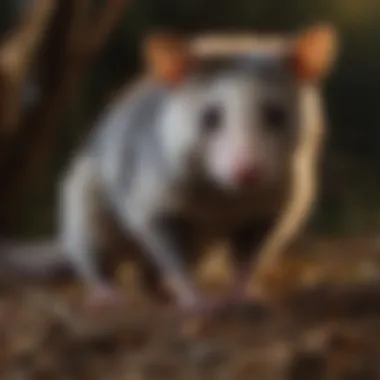
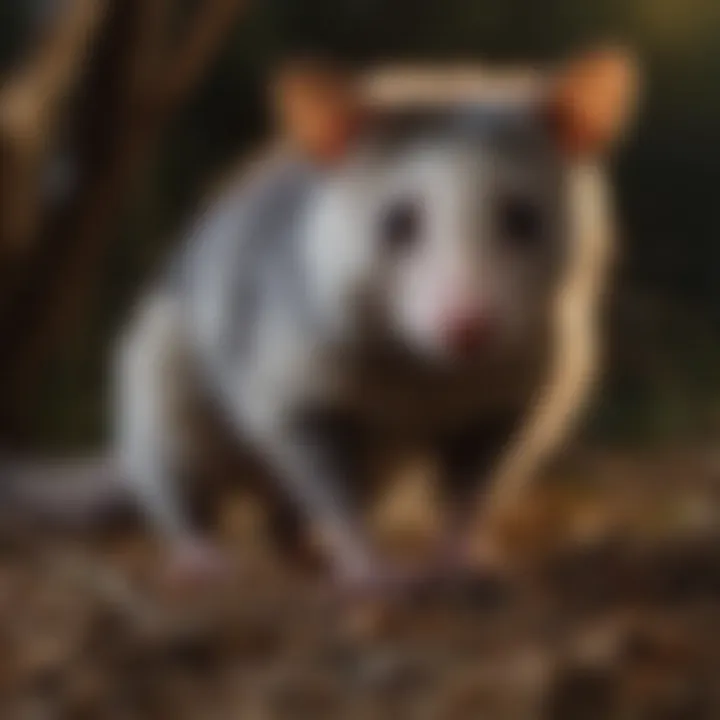
- Observe from a Distance: It can be beneficial to watch the area for a while after release without disturbing the opossum. Look for signs of them settling in or using the resources available.
- Health Checks: If possible, check for any signs of illness or injury. Ensuring that the animal is fit to survive is an important part of the overall process.
- Document Behavior: Keeping a record of their movements and behaviors can provide insights into the success of the release. This is particularly helpful for future trapping and releasing efforts.
- Community Reporting: Encourage neighbors and the community to report sightings or any issues with the released opossums. This not only helps in ongoing monitoring but can also foster awareness about humane pest management practices.
By adhering to these practices and maintaining a focus on the well-being of opossums, one can ensure effective and ethical management of these important wild creatures.
Common Challenges in Live Trapping
Live trapping of opossums presents unique challenges that every homeowner or pest control professional should understand. These challenges not only can affect the success rates of trapping but also have implications for the ethical treatment of the animals involved. Recognizing and addressing these challenges is essential to ensure an effective and humane trapping process.
Misidentification of Target Species
One of the principal issues in live trapping is the misidentification of target species. Opossums have a unique appearance, yet they can be confused with other nocturnal animals such as raccoons or small skunks. This confusion may lead to improper baiting and trap placement. For instance, using bait that attracts raccoons instead of opossums can lead to catches that were unintentional. Misidentification not only results in wasted effort and resources but also poses risks to other wildlife, which might be harmed or stressed when handled incorrectly.
To avoid this challenge, it is crucial to familiarize oneself with the physical characteristics and behavior of opossums. A few tips include:
- Study Visual Differences: Learn how to distinguish opossums from other similar animals. Opossums have a pointed snout, naked tail, and often a grayish-white fur.
- Observe Behavior: Opossums often play dead when threatened. Knowing this behavior can aid in identification and reduce unnecessary handling.
Trap Avoidance Behavior
Trap avoidance behavior is another common challenge that affects trapping success. Animals, including opossums, can become wary of traps due to previous experiences, particularly if they have been caught before. This avoidance behavior can cause opossums to avoid baited traps, and thus, they may seek alternative food sources elsewhere.
There are several approaches to minimize trap avoidance:
- Change Locations: If a trap remains unsuccessful after multiple checks, consider relocating it. Find new areas where opossums are frequently seen or where signs of their activity are evident, like droppings or tracks.
- Use Distinctive Baits: Baits can significantly influence the likelihood of attracting opossums. Experimenting with different food types and scents can help draw them towards the trap.
- Gradual Trap Introduction: To desensitize the opossums, place the trap without bait for a few days. Once they are accustomed to the presence of the trap, introduce bait to encourage their exploration.
Understanding these challenges allows for a more informed approach to live trapping. Addressing the issues of misidentification and trap avoidance will improve the overall effectiveness of the trapping process.
Integrating with Other Pest Management Strategies
Effective management of opossum populations requires understanding their role within the broader context of pest management. Integrating live trapping with other pest control methods leads to a holistic approach that benefits both homeowners and the environment.
Complementary Approaches
Incorporating complementary strategies enhances the effectiveness of live trapping. These methods can include habitat modification, exclusion techniques, and the use of repellents. Habitat management is critical; removing food sources and potential nesting sites can dissuade opossums from frequenting specific areas. For instance, securing garbage cans and cleaning up fallen fruit can naturally limit access to food.
Exclusion methods involve sealing entry points to structures, ensuring opossums cannot nest in attics or under decks. If they cannot enter, they will not stay. When employing traps, consider using repellents with caution. Repellents like predator urine or commercial deterrents can disrupt normal behavior, making live trapping more likely to succeed. However, the application must be carefully managed, so as not to drive the opossums into other areas, potentially increasing conflict elsewhere.
Long-Term Management of Opossum Populations
Long-term management strategies create a sustainable environment regarding opossum populations. After trapping and relocating opossums, the focus shifts to preventing future conflicts. This includes monitoring local populations and understanding community dynamics.
Community engagement plays a significant role. Educating neighbors on humane practices, safe food storage, and habitat modification creates a unified effort against unwelcome wildlife. This education can take form through workshops, community meetings, or informational brochures distributed through local channels. Homeowners working together can greatly reduce opossum attractants, fostering an environment less prone to wildlife conflict.
Regular monitoring of the situation helps assess the effectiveness of integrated strategies. If opossums continue to appear despite management attempts, reassessing the chosen approaches may be necessary. Flexibility is essential, as what works for one neighborhood may not suit another. In this context, understanding the specific behaviors and ecology of opossums in the area enables better decision-making.
Integrating live trapping with other pest management strategies is a pragmatic approach for homeowners. Coupling these methods can enhance overall success and ensure a balanced ecosystem that considers the ecological importance of opossums.
Educating the Community
Educating the community about opossum ecology and humane trapping holds significant importance. An informed public can make a substantial difference in managing opossum populations effectively and ethically. Raising awareness facilitates better understanding of the role opossums play in the ecosystem, which can lead to more informed decisions about their management. Furthermore, a community that is educated about humane practices is more likely to adopt strategies that minimize stress and harm to wildlife, fostering a sense of responsibility and stewardship toward all creatures.
Raising Awareness on Opossum Ecology
Understanding opossum ecology is essential for effective management. Opossums are often misunderstood animals, regarded more as a nuisance than a beneficial part of the environment. They serve key roles such as pest control by eating insects and small rodents. By educating community members about these positive aspects, we can reduce negative perceptions.
Emphasizing their resilience and adaptability showcases how these animals have coexisted with humans for centuries. Knowledge about their behavior, habitat needs, and nocturnal lifestyle demystifies their presence in urban settings.
- Key benefits of raising awareness include:
- Decreasing human-wildlife conflict
- Promoting biodiversity by understanding species contributions
- Enhancing public support for humane management practices
Promoting Humane Practices
Promoting humane practices in capturing and managing opossums is of utmost importance. This means advocating for live trapping methods and proper release techniques. An understanding that opossums are vital to the ecosystem aids in persuading community members to avoid harmful traps or lethal measures.
Humane practices encompass several elements:
- Use of appropriate live traps that minimize harm
- Regular monitoring of traps to ensure captured opossums are not confined for long durations
- Safe handling methods to reduce stress during transfer and release
- Community engagement efforts, such as workshops or informational sessions, to educate others
Implementing humane practices ensures not only the well-being of opossums but also fosters a compassionate community ethos.
Ultimately, educating the community encourages responsible behaviors and decision-making regarding wildlife management. With thorough knowledge of opossum ecology and humane trapping practices, homeowners and others can engage in practices that contribute positively to their environment.
Epilogue
One significant element is acknowledging the ecological role of opossums. They are vital in controlling insect populations and dispersing seeds, offering numerous benefits to our environment. Therefore, managing their population through humane trapping is not just about removal, but also ensuring their continued presence in the ecosystem.
Moreover, understanding the proper methods of handling and releasing captured opossums is crucial. This minimizes their stress and enhances the likelihood of survival after release. Adhering to local laws and ethical guidelines reflects respect for wildlife, which is increasingly important in modern pest management practices.
Overall, the practices discussed in this article serve to educate homeowners and pest control professionals alike. By integrating humane trapping techniques with knowledge about opossum behavior and ecology, effective management can be achieved, leading to a balanced coexistence with these often-misunderstood marsupials.
Summary of Effective Practices
- Use Appropriate Traps: Choose the right size and type of trap, such as box traps or cage traps, based on your needs.
- Optimal Baiting: Select baits that attract opossums and place them strategically in traps.
- Routine Monitoring: Regularly check traps to ensure the humane treatment of captured animals and reduce stress for the opossums.
- Safe Handling: Employ gentle techniques when handling captured opossums, minimizing stress and injury risks during transfer.
- Respect Regulations: Familiarize yourself with local trapping laws to ensure compliance.
- Post-Release Care: Monitor released opossums briefly to ensure they regain their bearings in the environment.
Implementing these effective practices offers a comprehensive approach to managing opossum populations, while promoting a humane and responsible attitude toward wildlife.







